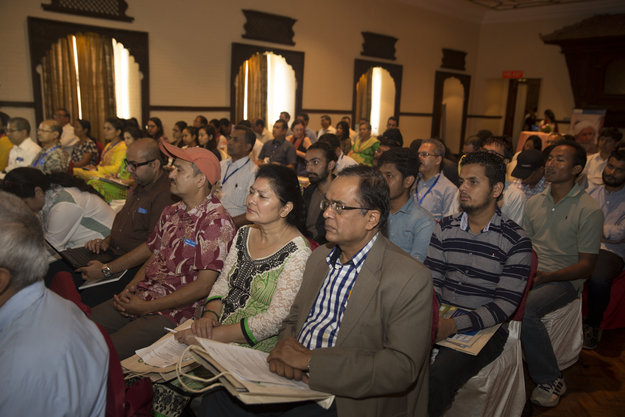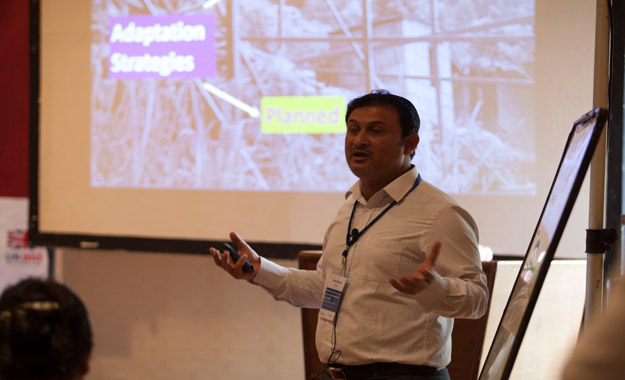The Hindu Kush Himalayan (HKH) region, the source of ten large river systems of Asia, providing water and other ecosystem services to more than 210 million people living in the mountains and over1.3 billion downstream, is the “Water Towers of Asia”. Characterized by the youngest, highest and some of the most fragile mountain systems in the world, the HKH region and its glacier- and snow-fed downstream river basins are highly vulnerable to climate change. Climate change-induced shifts in the timing and pattern of precipitation and of glacier and snow runoff in the region are already having impact on water resources, including water availability and energy security across the region. Although the people in the region have been coping with or adapting to climate change impacts in their own ways for centuries, this is not enough. Planned adaptation is also needed in addition to ongoing coping strategies and autonomous adaptation. Adaptation measures or strategies based on traditional and indigenous knowledge but informed by modern science and tried and tested “evidence” of workability are needed. However, we do not know enough about the local, seasonal, and sectoral impacts of climate change, how people are adapting to climate change impacts, and what adaptation measures work, when, for whom, and at what scale.
HI-AWARE believes that scientific research needs to be used and should influence policy and practice in adapting to climate change. A consultation workshop on ‘Adaptation to Climate Change Impacts in Gandaki River Basin of Nepal’ was organized on August 10, 2016 at Kathmandu. The workshop was co-organized by international NGO ‘Practical Action‘. The workshop shared the initial results of HI-AWARE research with policymakers and practitioners. Further, it identified and prioritized suitable adaptation measures for Gandaki river basin. This is a culmination workshop brought together learning from a series of local-level stakeholder engagement events held in Nuwakot, Rasuwa and Chitwan districts of Nepal earlier this year.
Chairing the inaugural session, Dr. Eklabya Sharma, Director Programme Operations, ICIMOD, said that engagement with policy makers and practitioners is important for HI-AWARE research. This will help in understanding the requirements from the immediate stakeholders so that the research could be used for the benefits of the people.
 Audience members at the workshop.
Audience members at the workshop.
Presenting about HI-AWARE research, Dr. Anjal Prakash, Programme Coordinator, HI-AWARE, informed that the research is focusing on how people are adapting to the change process in High Mountain, mid hills and flood plains of Indus, Upper Ganga, Gandaki and Teesta river basins. Informing the group about the research on biophysical drivers and conditions leading to vulnerability in HKH regions, Dr. Mandira Shrestha, Programme Coordinator, HYCOS, ICIMOD showed the early results of the warming trends are alarming. She showed that the modeling work done to show future climate projections and impact scenarios. The same is helpful in planning adaptation at the local level. Dr. Pranita B Udas, Gender Specialist at ICIMOD highlighted the key findings on issues of vulnerabilities with respect to climatic stressors in three stretches i.e. upstream, midstream and downstream of Gandaki river basin. Dr. Bimal Raj Regmi, Governance Specialist, ICIMOD presented the findings of research on the documentation and analysis of successful autonomous and planned adaptation practices happening in the Gandaki river basin proved to be effective in building resilience of communities and livelihood systems.

Bimal Raj Regmi, presenting on adpatation measures within the Gandaki Basin
Gehendra Kesari Upadhyay DG of Department of Soil Conservation and Watershed Management said that the research on downscaling the data suits the need of the department especially for the sub-watershed management. He emphasized that in the villages, too much and too little water is a major issue which needed policy interventions for flood and drought management. He called for synergies with other governmental initiatives such as Harioban programme and bridge findings between upstream, midstream and downstream areas.
Mr.Gopi Khanal, Joint Secretary, Ministry of Federal Affairs of Local development talked about the environment friendly local government programme. The ministry is making a new strategy for urban resilience and the findings of the HI-AWARE programme will be used in the new strategy. He called for key research outcomes to be translated in Nepali for the use of people at the community level.
Mr.Madhukar Prasad Rajbhandari, Director General of Department of Water Induced and disaster management called for hazard and vulnerability related mapping and zoning for different regions. This information will help in understanding which are the high and low risk zones so that development planning can be done accordingly.
Gehendra Gurung, Practical Action explained the partnership with HI-AWARE programme and how local voices are brought into the research planning. He said that developing climate scenarios are an important step for planning adaptation. A further step needed to be taken to see how this would impact different sectors such as water and agriculture.
Dr. Eklabya Sharma, Director Programme Operation, ICIMOD summarized the session with five key messages coming out of the session:
First: there is a need to incorporate local knowledge with scientific knowledge for adaptation planning.
Second: the studies done need to feed to the planning and policy making process so engagement with policy makers and practitioners are important.
Third: the communication with local communities are important. It should be seen that the materials are translated in Nepali and made simple for the use of local communities in adaptation planning.
Fourth: vulnerability and hazard mapping and zoning is needed for high, mid and low disaster areas in Nepal.
Fifth: the relationships and linkages between upstream, midstream and downstream areas need to be studied further.
